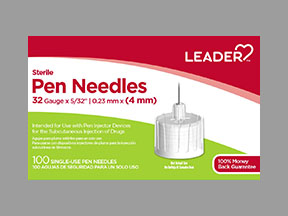
Pen Needles Coupons & Savings Card – Discount Prices from $21.87
Our coupons are free to use. Before paying, show the pharmacist your Pen Needles savings card to get your free discount. Use our filters below to edit the prescription box to match your needs. The Pen Needles prices will update based on your prescription needs. Above our Pen Needles coupons, you can change your location to see pharmacy prices and costs in other areas. We're here to help you buy Pen Needles at the lowest price with our prescription discount card.
My prescription
Edit
32G X 4 MM, Pen Needles (100 Miscellaneous)
Select pharmacy

Walgreens
$21.87
COUPON PRICEPen Needles savings card
Show this card to your pharmacist
Walgreens
$21.87
BIN
ID
PCN
GRP
019876
LHBEE25167
CHIPPO
LHX
Powered by
Our coupons are free to use. Before paying, show the pharmacist your Pen Needles savings card to get your free discount. Use our filters below to edit the prescription box to match your needs. The Pen Needles prices will update based on your prescription needs. Above our Pen Needles coupons, you can change your location to see pharmacy prices and costs in other areas. We're here to help you buy Pen Needles at the lowest price with our prescription discount card.
Our coupons are free to use. Before paying, show the pharmacist your Pen Needles savings card to get your free discount. Use our filters below to edit the prescription box to match your needs. The Pen Needles prices will update based on your prescription needs. Above our Pen Needles coupons, you can change your location to see pharmacy prices and costs in other areas. We're here to help you buy Pen Needles at the lowest price with our prescription discount card.
